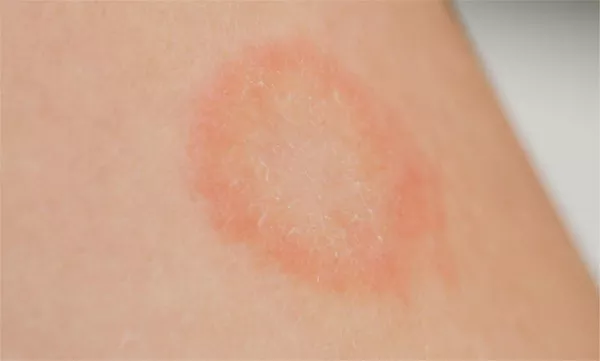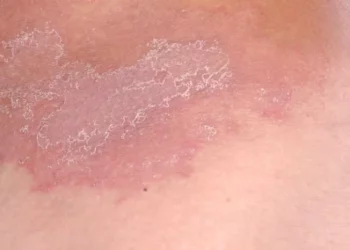Ringworm, also known as dermatophytosis, is a common fungal infection that affects the skin, scalp, and nails. Despite its name, it is not caused by a worm but by a group of fungi called dermatophytes. These fungi thrive in warm, moist environments and can spread through direct contact with an infected person, animal, or contaminated objects and surfaces. One question that often arises is whether ringworm can be contracted from swimming. This article delves into the relationship between swimming and ringworm, exploring how the infection spreads, potential risks in swimming environments, preventive measures, and treatment options.
Understanding Ringworm
What is Ringworm?
Ringworm manifests as red, itchy, circular patches on the skin. These patches may have raised edges and can occur on various parts of the body, including the scalp, feet (athlete’s foot), groin (jock itch), and nails. Key points include:
- Symptoms: Itchy, red, scaly patches with a ring-like appearance. The center may be clear or scaly.
- Transmission: Ringworm spreads through direct contact with an infected person, animal, or object (e.g., towels, clothing, surfaces).
Causes of Ringworm
The fungi responsible for ringworm belong to the genera Trichophyton, Microsporum, and Epidermophyton. These fungi thrive in warm, moist environments and can infect the outer layer of the skin, hair, and nails.
Can You Get Ringworm from Swimming?
Transmission Through Water
Swimming itself does not directly cause ringworm. However, swimming environments can create conditions that facilitate the spread of the fungi responsible for ringworm. Key considerations include:
- Moist Environments: Swimming pools, locker rooms, and showers are often warm and humid, creating ideal conditions for fungi to thrive.
- Surface Contamination: Fungi can survive on surfaces such as pool decks, locker room floors, and shower areas, posing a risk of infection if these surfaces are not properly cleaned and disinfected.
- Direct Contact: Sharing towels, clothing, or equipment with an infected person can facilitate the spread of ringworm.
Risk Factors in Swimming Environments
Several factors increase the risk of contracting ringworm in swimming environments:
- Poor Hygiene: Inadequate cleaning and disinfection of swimming facilities can lead to fungal contamination on surfaces and equipment.
- Crowded Facilities: High foot traffic in public pools, locker rooms, and showers increases the likelihood of contact with contaminated surfaces.
- Shared Equipment: Sharing towels, swimwear, and personal items with others can spread fungi.
- Skin Injuries: Cuts, scrapes, or abrasions provide an entry point for fungi, increasing the risk of infection.
- Immunocompromised Individuals: People with weakened immune systems are more susceptible to fungal infections.
Preventive Measures
Preventing ringworm in swimming environments involves a combination of personal hygiene practices and facility management strategies:
Personal Hygiene
- Shower Before and After Swimming: Rinsing off before entering the pool helps reduce the introduction of contaminants, while showering afterward helps remove any potential fungi acquired from the pool or locker room.
- Use Personal Towels: Avoid sharing towels, swimwear, or personal items with others to prevent the spread of fungi.
- Dry Off Thoroughly: Fungi thrive in moist environments, so it is important to dry off completely after swimming, paying special attention to areas like between the toes and skin folds.
- Wear Flip-Flops: Wearing flip-flops or water shoes in locker rooms, showers, and around the pool can help protect feet from contaminated surfaces.
- Keep Skin Healthy: Maintain healthy skin by moisturizing regularly and treating any cuts or abrasions promptly to reduce the risk of infection.
Facility Management
- Regular Cleaning and Disinfection: Swimming facilities should adhere to rigorous cleaning and disinfection protocols, focusing on high-touch surfaces, locker rooms, and showers.
- Proper Ventilation: Ensuring adequate ventilation in locker rooms and pool areas helps reduce humidity levels, making the environment less conducive to fungal growth.
- Water Quality Maintenance: Proper pool maintenance, including regular testing and adjustment of chlorine and pH levels, helps prevent the growth of fungi and other pathogens.
- Education and Awareness: Facility staff and patrons should be educated about the importance of hygiene practices and the risks of fungal infections to promote a healthier environment.
SEE ALSO: The Best Drug for Tinea Corporis
Treatment of Ringworm
If you suspect you have contracted ringworm, prompt treatment is essential to prevent the spread of the infection and alleviate symptoms:
Over-the-Counter Treatments
- Topical Antifungals: Creams, ointments, and sprays containing active ingredients like clotrimazole, miconazole, or terbinafine are effective for treating mild to moderate cases of ringworm.
- Application: Apply the antifungal medication directly to the affected area and surrounding skin as directed, usually for 2 to 4 weeks.
Prescription Treatments - Oral Antifungals: For severe or widespread infections, or cases that do not respond to topical treatments, a healthcare provider may prescribe oral antifungal medications such as terbinafine, itraconazole, or fluconazole.
- Topical Steroids: In some cases, a doctor may prescribe topical steroids to reduce inflammation and itching alongside antifungal treatment.
Home Care
- Keep the Area Clean and Dry: Regularly wash the affected area with soap and water, and dry thoroughly to prevent the fungi from thriving.
- Avoid Scratching: Scratching can worsen the infection and spread fungi to other areas of the body or other people.
- Wear Loose-Fitting Clothing: Loose, breathable clothing helps keep the skin dry and reduces irritation.
When to See a Doctor
Consult a healthcare provider if:
- The infection does not improve with over-the-counter treatments within 2 to 4 weeks.
- The infection spreads or worsens.
- You have underlying health conditions that may complicate treatment.
- The infection involves the scalp or nails, which typically require prescription treatment.
Conclusion
While swimming itself does not directly cause ringworm, swimming environments can facilitate the spread of the fungi responsible for the infection. By understanding the risk factors and implementing preventive measures, both individuals and facility managers can help reduce the risk of contracting ringworm. If an infection occurs, prompt and appropriate treatment is crucial to manage symptoms and prevent the spread of the infection. Maintaining good personal hygiene and advocating for proper facility maintenance are key steps in ensuring a healthy and enjoyable swimming experience.
Related Topics:


























